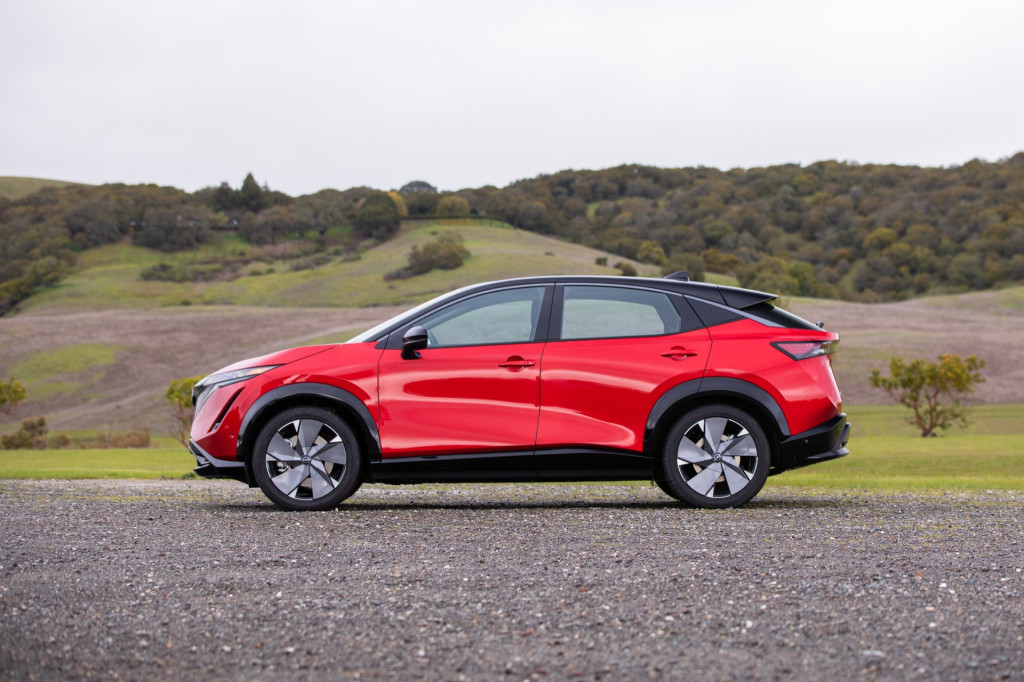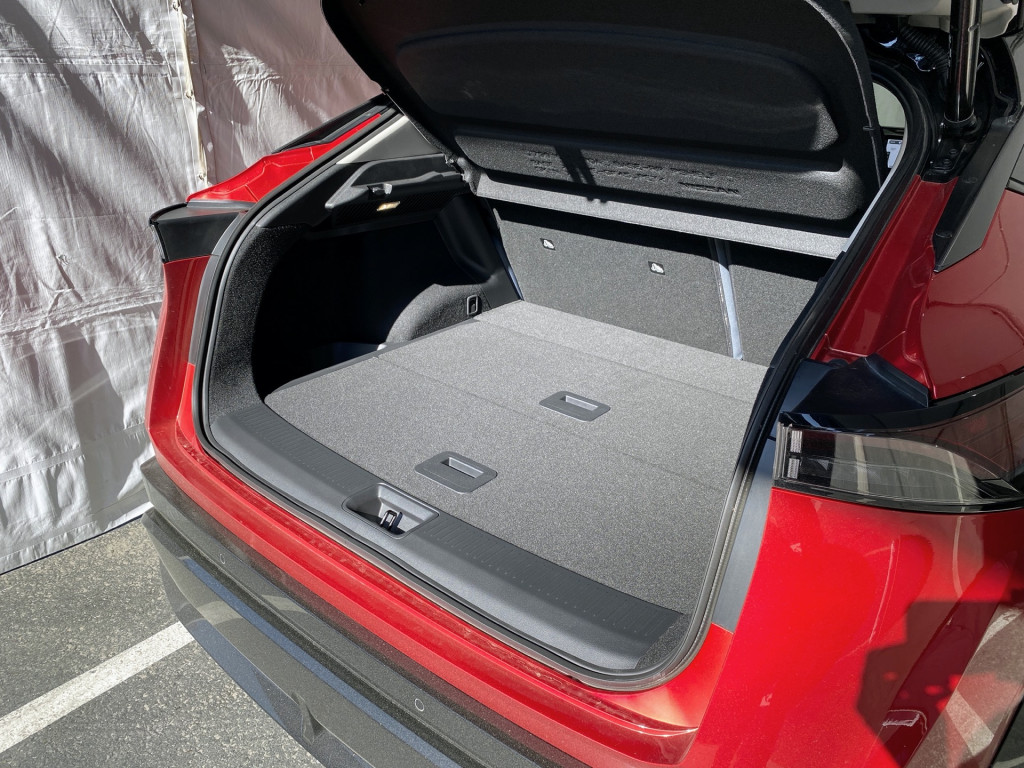The Ariya e-4orce is one of a growing cohort of dual-motor electric crossovers offering up all-weather traction and 0-60 mph times of less than five seconds. But as the e-4orce badging hints, it’s gone about its priorities in an entirely different way.
Across the market, these dual-motor models have their tradeoffs and aren’t always the best pick versus their single motor counterparts. An already heavy vehicle gets even heavier, and the ride is harder and pitchier to deal with the weight and extra power. And in real-world driving, perhaps partly because of the temptation of extra power, the loss of driving range can be even more exaggerated than the EPA numbers indicate.
It’s a lot to consider if you feel like your all-weather traction needs are a few days a year and blistering acceleration isn’t on your shopping list—or if accelerating to 60 mph in about seven seconds is just fine, thank you.
The biggest consideration may be the additional cost. The Volkswagen ID.4, Ford Mustang Mach-E, Hyundai Ioniq 5, and Kia EV6, among others, cost thousands of dollars more with two twisters.
2023 Nissan Ariya e-4orce
On all but the price premium, Nissan has taken a different approach with the 2023 Ariya e-4orce—one in which both motors play a role in aiding ride and handling all the other days of the year. After driving the e-4orce on storm-battered highways and backroads in California wine country this past week, I can report that the $4,000 premium for the e-4orce makes for a much more convincing upsell.
The e-4orce is stealthy, but its pedigree stems from models that aren’t so subtle. As a starting point, Nissan borrowed handling and body-control smarts from its ATTESA all-wheel performance system in the GT-R sports car, but retuned it for ride and handling in a quick family EV.
Simply put, Nissan doesn’t save one of the motors for higher speeds or higher-performance driving; it uses them both all the time, balanced around a 50/50 distribution. Nissan says that e-4orce can help adjust the attitude of the Ariya’s body, keeping it level when taking off quickly or avoiding nosedive when braking hard, for instance. As Nissan has shown in demos, it works for more than performance and traction.
To that point, it’s what the system does in between, in everyday touring conditions, that’s even more noteworthy. By subtly adjusting the distribution between the motors and gently actuating individual brake pads, it can modify the way the Ariya’s weight gets pitched around in corners. It’s one smooth operator, and it’s making adjustments in milliseconds.
At this past week’s drive, Nissan had a front-wheel-drive Ariya available for back-to-back comparisons, and it helped underscore the difference. While the AWD version is quite a bit heavier (about 400 pounds more in the fully loaded form we tested), and you can feel that in the steering wheel, the Ariya e-4orce felt far more composed on a curved local road with a heaved surface.

2023 Nissan Ariya e-4orce

2023 Nissan Ariya e-4orce

2023 Nissan Ariya e-4orce
Ariya e-4orce efficiency and range
For all it brings, e-4orce doesn’t detract from efficiency and range all that significantly—especially as I saw in real-world testing.
The Ariya e-4orce comes with a 272-mile EPA-rated range, with the top-of-the-line Platinum+ version I drove checking in at 267 miles. That’s really not much lower than the 289-mile rating earned by top-trim front-wheel-drive models, and from what I saw in a spirited, varied driving loop, it earned very close to that.
At the end of my drive the e-4orce Platinum+ was at a 33% charge with the trip computer guessing 93 miles remaining, suggesting 282 miles on a full charge.
I started at a 96% state of charge and averaged more than 3.3 miles per kwh over about 169 miles, including some rapid freeway driving, faster-moving two-laners, and slower, curvy coastal backroads. The climate control was on most of the way, but with outside temps a relatively mild 55 to 62 degrees Fahrenheit during the drive, my efficiency improved slightly toward the end of the day when the sun came out and I turned the climate system off.
According to Nissan, the motor type in the Ariya e-4orce plays a role in its efficiency. It uses both motors all the time rather than slipping into two-wheel-drive mode for cruising and anything but launches or performance driving, as some of those rivals would do. The Ariya uses an Externally Excited Synchronous Motor (EESM) design—one previously used by Renault—rather than a permanent-magnet motor or an induction motor.

2023 Nissan Ariya e-4orce
How quickly can the Ariya e-4orce accelerate?
The motors do have a tradeoff though. You’re simply not going to get the gasp-inducing off-the-line launches from the e-4orce that you see from other EVs with similar acceleration times. Provided you’re above 5 or 10 mph, the rush of acceleration is positively, quietly forceful, and its passing punch from about 40 to 70 mph, is breathtaking. It cuts the acceleration time to 60 mph from 7.2 seconds in single-motor versions down to 4.8 seconds.
Across Normal, Sport, and Eco modes, there isn’t a difference in the default distribution between front and rear wheels, but you will notice differences in steering boost and accelerator sensitivity.

2023 Nissan Ariya e-4orce
At the center console you can toggle an e-Step button that’s close to one-pedal driving but makes you press the brake pedal in the final few feet. Separately you can dial in a little more regenerative braking with the ‘B’ setting from the shift selector; that’s what I used for most of my drive.
Brake-pedal feel was one of my few dynamic gripes with the e-4orce. The pedal is soft, until you get to the friction brakes, but depending on the regen mode and seemingly the speed, that happens at a different height. I’d likely get used to it, but it’s a little off-putting at first.
The lack of fluster afforded by e-Power, the super-hushed interior, and what appears to be an impressive real-world driving range are all strong selling points. But what I see as the most alluring aspect of the Ariya versus rivals is its airy, spacious cabin and interface. The sparse yet attractive design offers up soft textiles and trim pieces that you just want to touch—and won’t be disappointed when you do.

2023 Nissan Ariya e-4orce
Ariya e-4orce cabin tech
While the Ariya focuses most controls on the pair of 12.3-inch displays—slightly curved toward the driver—shortcuts for the climate control lay across a middle belt of the dash in haptic buttons, and there’s a large physical volume knob.
Further haptic buttons on the center console help select drive modes. Throughout these interface points, there’s no lag; menus are intuitive and no more complex than they need to be; Android Auto and Apple CarPlay can wirelessly connect and be your interface point; and overall it allows you to tap into whatever information you need but not be swimming in it constantly.
Ariya e-4orce interior space
At about 183 inches long, 75 inches wide, and 65 inches high, the Ariya is slightly smaller than the Tesla Model Y but a size larger than the Volvo XC40 Recharge and C40 Recharge. Its 109-inch wheelbase is shorter than those of the Hyundai Ioniq 5 and Kia EV6, although it follows the same philosophy of truly maximizing interior space and opening up the floor wells.
The wide, high cabin space and open footwells add up to a real sense of airiness and space inside.

2023 Nissan Ariya e-4orce

2023 Nissan Ariya e-4orce

2023 Nissan Ariya e-4orce

2023 Nissan Ariya e-4orce
That follows from an outside design that doesn’t heap on the cheap-shot, faux-rugged design cues. It manages to combine a rakish coupe-SUV profile, as seen from the side, with a tall stance and a greenhouse that doesn’t narrow in a pronounced way toward the roof or taper much toward the tail.
Door cuts are generous, allowing this 6-foot-6 driver to get into the rearward-adjusted driver’s seat without banging into the pillar (an issue in this size of vehicle sometimes), with plenty of headroom below the panoramic roof. Likewise, the rear seats are spacious enough for adults, and throughout, the cushioning and bolstering are a league above what you’ll find in rival vehicles.
Cargo space is essentially the same between front-wheel-drive Ariyas and the e-4orce version, although the deep covered cargo well that allows some extra hideaway space in the former is traded off for propulsion components in the latter.

2023 Nissan Ariya e-4orce
Ariya e-4orce price and value
While every other rival model saves its dual-motor version for the large battery pack, you can get the Ariya e-4orce with its 66-kwh battery pack (63 kwh usable), in $48,485 Engage trim (including the $1,295 destination).
In that form, power and torque are somewhat limited, to 335 hp and 413 lb-ft. But given what I saw on my drive, e-4orce is more about the confidence and the confort than all-out performance. The most affordable e-4orce model might be the best deal in the Ariya lineup right now, and perhaps one of the best deals among dual-motor EVs for those who like the idea of always-on all-wheel drive but don’t need huge amounts of range or performance.
With the larger pack, Nissan says that the Ariya can DC fast-charge from 20-80% in 40 minutes. On 240-volt AC, with its 7.2-kw onboard charger, it can go from 0-100% in 14 hours. With the smaller pack those times drop to 35 minutes and 10.5 hours, respectively.
In all of its versions, the Ariya includes both a heat pump and battery warmer to help keep range within expectations, even when temperatures skew to extreme cold. And the battery pack is liquid-cooled so, unlike earlier versions of the Leaf, there shouldn’t be such concerns about hot-weather degradation.
In the top Platinum+ version of the Ariya e-4orce I drove, both ProPilot automated parking and ProPilot Assist were also included. The latter now includes hands-free lane changes and allows cruising on limited-access freeways without needing to periodically touch the steering wheel, as long as the driver monitor camera detects that you’re paying attention to the road. I saw both for a short test, although it wasn’t enough to report on the usefulness of the system.
The Ariya e-4orce Platinum+ costs $61,485 and includes a head-up display, a panoramic roof, a power tailgate, power front seats, heated front and rear (outboard) seats, and a wireless charging pad. Exclusive to the Platinum+ level are Bose audio, a multi-color cabin illumination system, ProPilot Assist, and available 20-inch wheels.

2023 Nissan Ariya e-4orce
Ariya e-4orce takeaways
The Ariya is compatible with over-the-air updates for the entire vehicle, and although Nissan hasn’t put this ability to use yet it will likely prove very useful in the future.
Overall, the Ariya e-4orce promises great handling, and it delivers that, but even more so, Nissan’s strategy results in an exceptionally comfortable ride—one that goes perfectly with the Ariya’s posh yet no-fuss interior.
The 2023 Nissan Ariya e-4orce reminds us that smoother can be faster, and smoother is always better. This is a rare exception on the market, in which the model with lots more power has the more comfortable ride. If you like moving quickly but feeling composed all the way, check that box.
